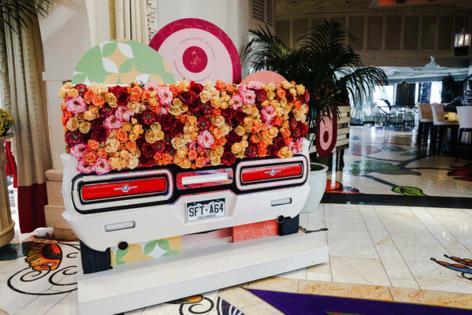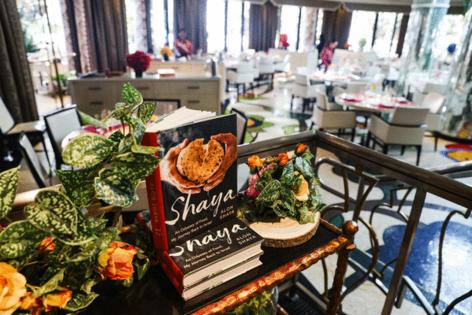Celebrated chef channels groovy 1960s vibe for Las Vegas residency
Published in Variety Menu
LAS VEGAS -- It’s 1964. Safta is feeling groovy. She’s wearing a Pucci shift. And Courrèges sunglasses: big white ovals. And bejeweled Jack Rogers sandals. She gives her zippy T-Bird convertible a little more gas. Next stop: Las Vegas, where she’ll set up in a midcentury bungalow and throw parties for the Vegas ton, serving her favorite recipes.
Safta is going to arrive.
And so she has, in spirit, at Safta 1964, a culinary residency that has settled into its extended run at Jardin restaurant in Encore. Celebrated chef Alon Shaya, a James Beard Award winner, created the residency as a new version of his Michelin-recognized Safta (no 1964) in Denver.
Safta means “grandmother” in Hebrew, and Safta 1964 takes its name from a real safta: Matilda Gerassi, Shaya’s maternal grandmother. Her fictional midcentury heyday inspired the restaurant.
“When we had the opportunity to bring Safta to Las Vegas, I thought, ‘How can we make it a fun and interesting take on if my Safta had driven west to Vegas and lived here when she was young, with all her decorating talents and love of entertaining?’
“My grandmother was a really huge part of my life and really got me to fall in love with cooking from the age of 7 years old in the kitchen. The recipes and energy we try to create are honoring how she shaped the way I think and cook.”
The menu at Safta 1964 is broadly Mediterranean and Middle Eastern, drawing on Shaya’s family history and his progress as a chef and an essential question: What would Safta want to cook when she was out here?
A culinary epiphany
Safta 1964 represents a homecoming of sorts for Shaya, who interned in Vegas in the late 1990s. He later apprenticed in Italy and made his name cooking in Italian restaurants in the U.S. In 2013, he had a culinary epiphany.
“I was in Israel, walking through the markets. I hear women in the markets talking to each other. It sounded like my Safta’s voice — she spoke Hebrew,” the chef said. “A light bulb went off: Why have I not been embracing the food I grew up eating? I started putting za’atar on my pizza crusts. I wrote down everything my Safta made and began cooking that food.”
The epiphany lead to Shaya opening Israeli restaurants that ultimately led to Safta 1964, “a poem that takes into account a lifetime’s influence and experience.”
A classic with caviar, because Vegas
You might begin dinner at Safta 1964 with hummus (a favorite dish of Safta’s) topped by warm buttered blue crab, sliced chives and hits of lemon zest. And a fat quenelle of Osetra caviar — “because Safta lives here in Vegas,” Shaya said. Hot steaming pita, made from freshly milled wheat grown on a small Oklahoma farm, accompany the hummus.
For falafel, a dish he’s been making for years, the chef folds in egg whites during cooking. The falafel is backed by three adjutants: tahini infused with lemon and garlic; amba, a tart-sweet Iraqi condiment made from pickled mangoes; and schug, a Yemenite sauce uniting cilantro, serranos, allspice and extra-virgin olive oil.
“The way we present the falafel makes you feel like you’re seeing a painting or the colors of wallpaper or a couch back in the ’60s,” Shaya said.
A salatim platter, from the Hebrew word for “salads,” includes lutenitsa, another Safta signature that features roasted eggplant, peppers, tomatoes and garlic.
“Every time she cooked, there was always pepper and eggplants charring over the fire and filling the whole house with this incredible aroma. From a really young age, I connect that with family,” Shaya said. “This is the dish she would be most proud of. It’s the dish I credit with making me fall in love with food at a very young age.”
‘A high-end fish’
Safta’s dinner party is only getting started.
For crisp eggplant back in the day, she’d rub slices with caramelized tomato paste, bread and fry them, then serve the eggplant between white bread swiped with Philadelphia cream cheese.
“As I’ve grown as a chef, I don’t feel the need to serve slices of white bread and Philly cream cheese,” Shaya said. “Instead, I use goat cheese infused with herbs and garlic. So, when you eat it, it feels like eggplant Parmesan on a whole other level.”
A rich purple salad of beets, tahini, saffron and dill, a classic salatim, is piped in a circle about a filet of Ora King salmon, then set with edible flowers.
“It really makes me feel the energy of 1964. It feels like the kind of dish Safta would have made to show off to her friends,” the chef said. “I created it specifically for this restaurant; we don’t serve it anywhere else.”
Shaya’s father grew up in Romania near the Hungarian border. Paprikash dishes derived from the Hungarian paprikash stew, especially chicken with paprika, were a mainstay of midcentury American menus. For his paprikash, the chef swaps out chicken for sablefish, often called black cod.
“Sablefish being one of my favorite things in the world to eat, and growing up and going to the Jewish deli and getting sablefish on my bagel, I felt like sablefish rubbed with paprikash went together,” Shaya said.
“Sablefish is a high-end fish. It’s a dish I felt lived up to the glitz and glamour of Las Vegas and was also deeply rooted in my family and where they are from and the recipes I ate growing up.”
Midcentury wiggle
Molded Jell-O also took pride of place in midcentury American entertaining, in sweet and savory versions entombing all manner of ingredients: pineapple, sliced green olives, peas, ham, eggs and more. The Jelleaux service at Safta 1964 showcases cherry-lime beauties incorporating whipped crème fraîche. They’re shaped in vintage molds, presented on cake stands and carved tableside. Jennifer Yee, executive pastry chef of Wynn Las Vegas-Encore, joined with Shaya to create the Jelleaux.
“The cart is going through the dining room, the Jelleaux is wiggling, people are going, ‘What is this?’ ” Shaya said.
Safta 1964 is open for dinner Fridays through Tuesdays. Wear a vibrantly colored caftan. Safta would.
©2024 Las Vegas Review-Journal. Visit reviewjournal.com.. Distributed by Tribune Content Agency, LLC.












Comments